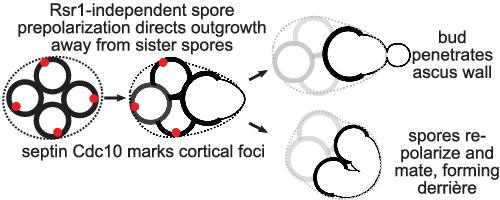Our official English website, www.x-mol.net, welcomes your
feedback! (Note: you will need to create a separate account there.)
Saccharomyces spores are born prepolarized to outgrow away from spore–spore connections and penetrate the ascus wall
Yeast ( IF 2.2 ) Pub Date : 2020-11-25 , DOI: 10.1002/yea.3540 Lydia R Heasley 1, 2 , Emily Singer 1 , Benjamin J Cooperman 1 , Michael A McMurray 1
Yeast ( IF 2.2 ) Pub Date : 2020-11-25 , DOI: 10.1002/yea.3540 Lydia R Heasley 1, 2 , Emily Singer 1 , Benjamin J Cooperman 1 , Michael A McMurray 1
Affiliation

|
How nonspore haploid Saccharomyces cells choose sites of budding and polarize towards pheromone signals in order to mate has been a subject of intense study. Unlike nonspore haploids, sibling spores produced via meiosis and sporulation by a diploid cell are physically interconnected and encased in a sac derived from the old cell wall of the diploid, called the ascus. Nonspore haploids bud adjacent to previous sites of budding, relying on stable cortical landmarks laid down during prior divisions, but because spore membranes are made de novo, it was assumed that, as is known for fission yeast, Saccharomyces spores break symmetry and polarize at random locations. Here, we show that this assumption is incorrect: Saccharomyces cerevisiae spores are born prepolarized to outgrow, prior to budding or mating, away from interspore bridges. Consequently, when spores bud within an intact ascus, their buds locally penetrate the ascus wall, and when they mate, the resulting zygotes adopt a unique morphology reflective of repolarization towards pheromone. Long‐lived cortical foci containing the septin Cdc10 mark polarity sites, but the canonical bud site selection programme is dispensable for spore polarity, thus the origin and molecular composition of these landmarks remain unknown. These findings demand further investigation of previously overlooked mechanisms of polarity establishment and local cell wall digestion and highlight how a key step in the Saccharomyces life cycle has been historically neglected.
中文翻译:

酵母菌孢子出生时预极化,远离孢子-孢子连接并穿透子囊壁
非孢子单倍体酵母细胞如何选择出芽位点并向信息素信号极化以进行交配一直是一个深入研究的主题。与非孢子单倍体不同,二倍体细胞通过减数分裂和孢子形成产生的同胞孢子在物理上相互连接并包裹在源自二倍体旧细胞壁的囊中,称为子囊。非孢子单倍体在先前的出芽位点附近出芽,依赖于先前分裂期间放置的稳定的皮层标志,但由于孢子膜是从头制造的,因此假设,正如裂殖酵母所知,酵母菌孢子打破对称性并随机极化地点。在这里,我们证明了这个假设是不正确的:Saccharomyces cerevisiae在出芽或交配之前,孢子在出生前经过预极化,远离孢子间桥而长出来。因此,当孢子在完整的子囊内萌芽时,它们的芽会局部穿透子囊壁,当它们交配时,产生的受精卵采用独特的形态,反映了对信息素的复极化。包含 septin Cdc10 标记极性位点的长寿皮层病灶,但规范芽位点选择程序对于孢子极性是可有可无的,因此这些标记的起源和分子组成仍然未知。这些发现要求进一步研究先前被忽视的极性建立和局部细胞壁消化机制,并强调酵母菌生命周期中的一个关键步骤在历史上是如何被忽视的。
更新日期:2020-11-25
中文翻译:

酵母菌孢子出生时预极化,远离孢子-孢子连接并穿透子囊壁
非孢子单倍体酵母细胞如何选择出芽位点并向信息素信号极化以进行交配一直是一个深入研究的主题。与非孢子单倍体不同,二倍体细胞通过减数分裂和孢子形成产生的同胞孢子在物理上相互连接并包裹在源自二倍体旧细胞壁的囊中,称为子囊。非孢子单倍体在先前的出芽位点附近出芽,依赖于先前分裂期间放置的稳定的皮层标志,但由于孢子膜是从头制造的,因此假设,正如裂殖酵母所知,酵母菌孢子打破对称性并随机极化地点。在这里,我们证明了这个假设是不正确的:Saccharomyces cerevisiae在出芽或交配之前,孢子在出生前经过预极化,远离孢子间桥而长出来。因此,当孢子在完整的子囊内萌芽时,它们的芽会局部穿透子囊壁,当它们交配时,产生的受精卵采用独特的形态,反映了对信息素的复极化。包含 septin Cdc10 标记极性位点的长寿皮层病灶,但规范芽位点选择程序对于孢子极性是可有可无的,因此这些标记的起源和分子组成仍然未知。这些发现要求进一步研究先前被忽视的极性建立和局部细胞壁消化机制,并强调酵母菌生命周期中的一个关键步骤在历史上是如何被忽视的。











































 京公网安备 11010802027423号
京公网安备 11010802027423号